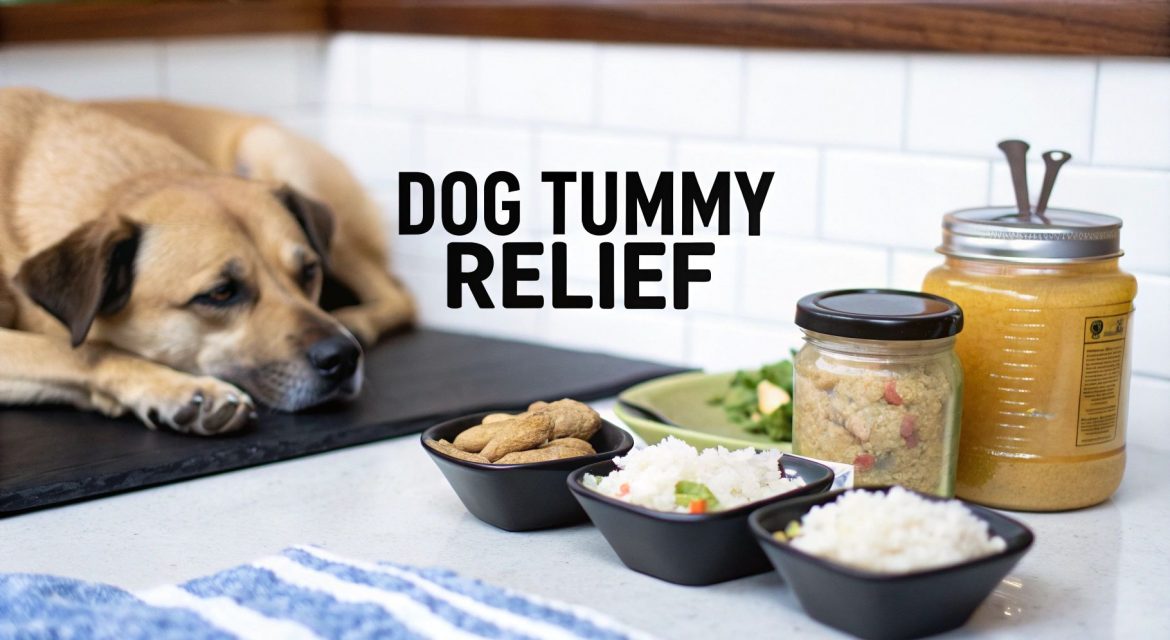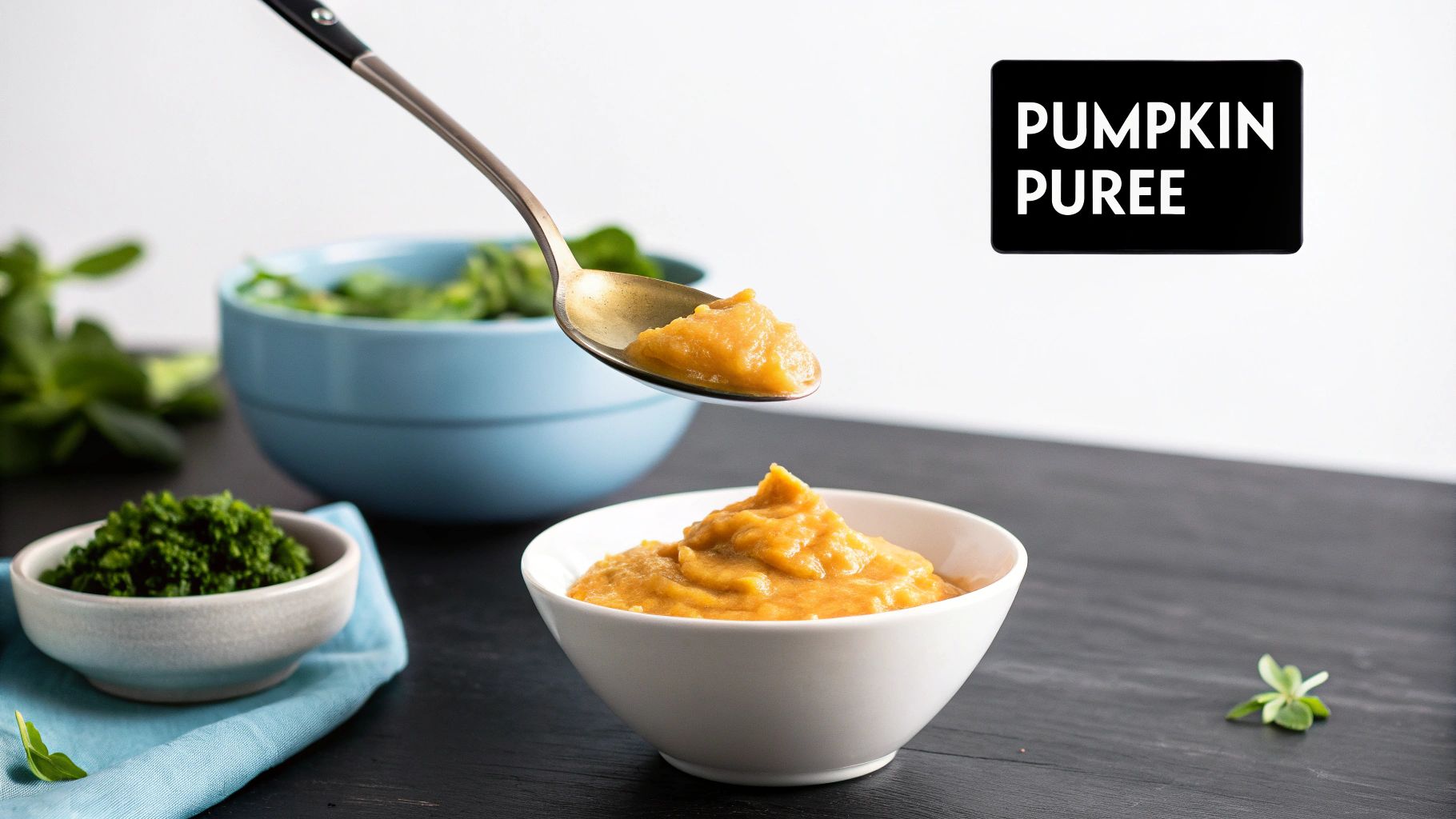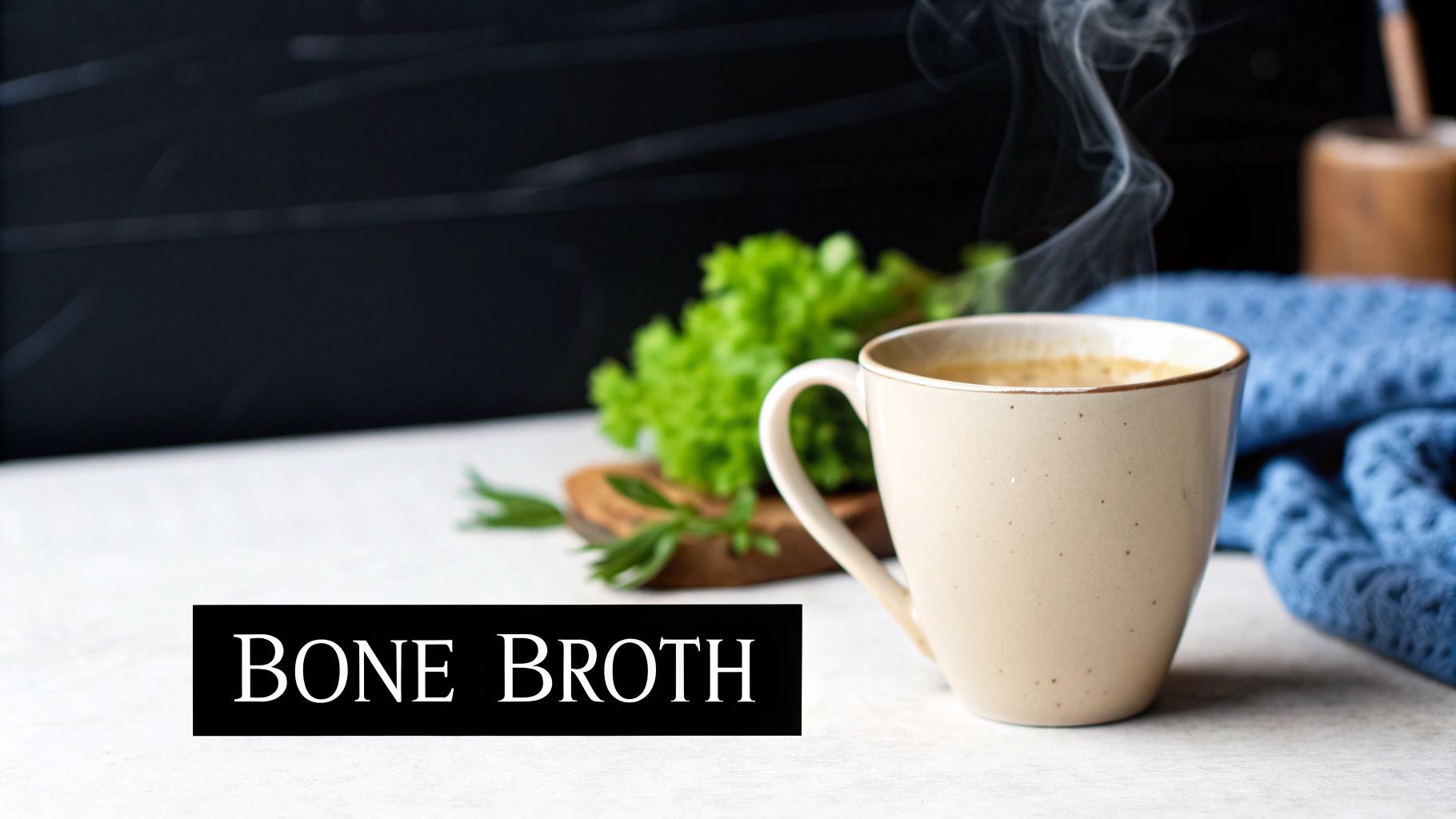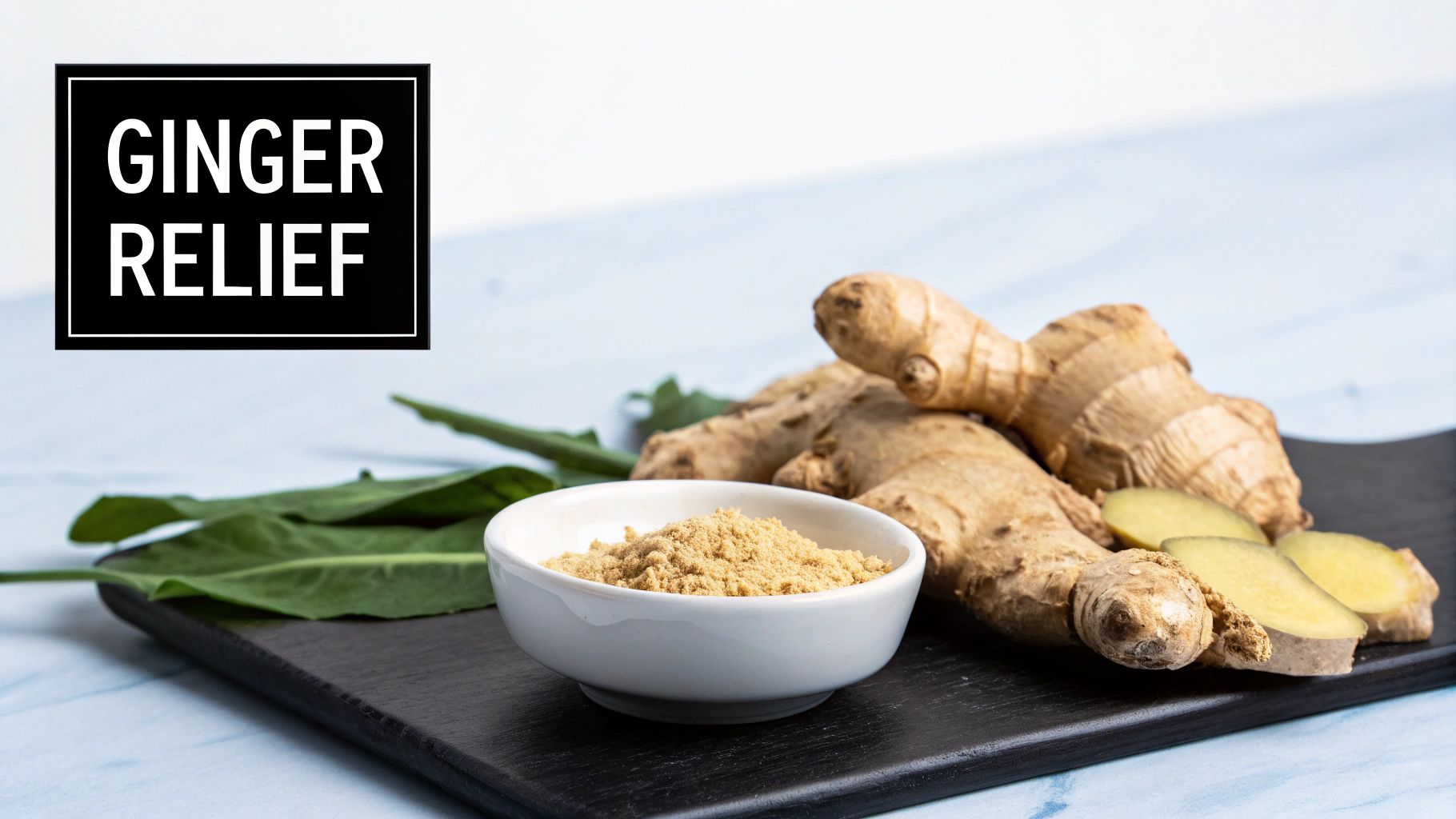That worried look, the lethargy, the tell-tale gurgling sounds from their belly – as pet owners, we know the signs all too well. Seeing our beloved dogs uncomfortable with an upset stomach is heart-wrenching. You feel helpless, wishing you could take their discomfort away instantly. We've all been there, pacing the floor at 2 a.m., wondering what to do.
The good news is, you're not alone, and there are many gentle, effective ways we can help. Before rushing to conclusions, it's comforting to know that many minor tummy troubles can be managed safely right at home. This guide will walk you through eight trusted dog upset stomach remedies, from vet-approved bland diets to natural soothing agents. We'll explore not just what to do, but why these remedies work and how to use them safely, empowering you with the confidence to care for your companion when they need you most.
Together, we'll cover a range of options you can implement right away, providing clear, actionable steps for each one. This includes preparing a simple bland diet, understanding the benefits of a short fast, and using natural supplements like pumpkin or ginger. Our goal is to give you a practical toolkit for those stressful moments, helping you bring your furry friend back to their happy, tail-wagging self. Let's get them on the road to recovery together.
1. Bland Diet (Chicken and Rice)
When your dog is dealing with an upset stomach, one of the most reliable and vet-recommended remedies is a temporary switch to a bland diet. We've all heard of it, and the classic combination of boiled chicken and white rice is a go-to for a reason. It’s gentle, easily digestible, and provides essential nutrients without overburdening a sensitive digestive system, allowing it to rest and recover.
The magic of this simple meal lies in its composition. The boiled chicken breast offers lean protein for energy and tissue repair, while plain white rice provides easily digestible carbohydrates. This combination is deliberately low in fat and fibre, which can be difficult for an irritated gut to process. This approach is so effective that you'll find it's routinely used in veterinary hospitals for post-operative recovery and in animal shelters to help new arrivals adjust.
How to Prepare and Serve
Preparing this remedy is straightforward, but getting the details right is crucial for success. Here's how we can do it:
- Preparation: Boil a skinless, boneless chicken breast until it's thoroughly cooked. Remember, don't add any oils, salt, or seasonings. Cook plain white rice separately, ensuring it is soft.
- Ratio: The ideal ratio is typically one part shredded or diced chicken to three parts rice. This ensures the meal is primarily easy-to-digest carbohydrates.
- Serving: Allow the food to cool completely to room temperature before you serve it. Feed your dog small, frequent meals throughout the day (e.g., four to six small portions) instead of one or two large ones. This prevents overloading their stomach.
Transitioning Back to Normal Food
A bland diet is a short-term solution, usually for just a few days. Once your dog's stools are firm and they seem to be feeling better, you can begin to gradually reintroduce their regular food over 3-5 days. Start by mixing a small amount of their normal kibble into the chicken and rice, slowly increasing the proportion of their regular food at each meal. For a deeper understanding of dietary needs, you can explore more about foundational canine nutrition.
2. Fasting (12-24 Hour Food Restriction)
It might feel counterintuitive to withhold food when your companion isn't feeling well, but a short, controlled fast is one of the most effective dog upset stomach remedies. This approach involves restricting food for 12 to 24 hours, giving their gastrointestinal tract a much-needed break. This pause allows the inflamed stomach and intestines to settle down and begin healing without the added stress of digesting a meal.
This method is a cornerstone of traditional veterinary advice and is often the first step recommended by emergency clinics for minor digestive issues. By giving the digestive system a complete rest, you allow your dog's natural healing processes to take over. It’s a simple, natural, and highly effective way to manage acute cases of vomiting or diarrhoea, helping to "reset" the system before we reintroduce food.
How to Implement a Fast Safely
While simple, fasting must be done correctly to be safe and effective. It's generally suitable for healthy adult dogs but should be avoided for puppies, elderly dogs, or those with underlying health conditions like diabetes unless your vet specifically directs it.
- Duration: A 12-hour fast is a great starting point. For most healthy adult dogs, you can extend this up to 24 hours if needed.
- Water Access: Crucially, never restrict water. Your dog must have constant access to fresh, clean water to prevent dehydration, which can be a serious risk, especially if they have diarrhoea or are vomiting.
- Environment: Keep your dog comfortable and calm during the fast. Avoid strenuous activity and provide a quiet space for them to rest.
Breaking the Fast
After the fasting period, it's vital to reintroduce food carefully to avoid upsetting the stomach again. Don't go straight back to their regular food. Start with a small portion of a bland diet, like the chicken and rice we mentioned earlier. If they keep this down without any issues, you can offer another small meal a few hours later. Gradually transition back to their normal diet over the next few days. For more detailed guidance on what to feed after a bout of digestive trouble, you can find helpful tips on choosing the right dog food for diarrhoea.
3. Pumpkin Puree
Among the most trusted natural dog upset stomach remedies, plain pumpkin puree stands out as a simple yet powerful digestive aid. This pantry staple is celebrated for its high soluble fibre content, which works wonders for regulating your dog’s digestive system. It can uniquely help with both diarrhoea and constipation by either absorbing excess water to firm up stools or adding bulk to help things move along smoothly.
The effectiveness of pumpkin lies in its ability to support the gut without causing further irritation. The fibre acts as a prebiotic, feeding the beneficial bacteria in your dog's intestines and promoting a healthy gut microbiome. It's also packed with essential nutrients like vitamins A, C, and E, plus minerals such as potassium and iron, offering a nutritional boost while soothing their tummy. This is why you'll often find holistic veterinarians and dog daycare facilities keeping it on hand for pups with minor digestive issues.
How to Prepare and Serve
Adding pumpkin to your dog’s diet is easy, but it’s vital to use the correct type and amount to ensure it helps rather than hinders.
- Preparation: Use 100% pure, canned pumpkin puree, not pumpkin pie filling. The pie filling contains added sugars, spices (like nutmeg, which is toxic to dogs), and other ingredients that can worsen an upset stomach.
- Dosage: A general guideline is to add one to four tablespoons to your dog's meal, depending on their size. It's always a good idea to start with a smaller amount to see how they tolerate it.
- Serving: You can mix the puree directly into their food, such as a bland diet of chicken and rice, for a combined soothing effect. For convenient, pre-portioned servings, you can even freeze the puree in an ice cube tray.
When to Use This Remedy
Pumpkin is a fantastic short-term solution for mild cases of diarrhoea or constipation and is not intended for long-term daily use without veterinary guidance. It's a gentle option for stabilising your dog's digestion after a minor dietary indiscretion or during stressful events like travel. If your dog's symptoms are severe or persist for more than a couple of days, it's crucial to stop home treatment and consult your vet. This ensures you’re not overlooking a more serious underlying health problem.
4. Probiotics
When your dog's digestive system is out of balance, probiotics can be a powerful tool for restoring order. These beneficial bacteria are live microorganisms that work to support a healthy gut environment. By introducing good bacteria, you can help crowd out harmful pathogens, improve nutrient absorption, and fortify your dog's natural digestive defences, making this one of the most effective dog upset stomach remedies available.
Probiotics work by re-establishing a healthy balance of microflora in the gut, which can be disrupted by stress, diet changes, illness, or medications like antibiotics. This rebalancing act not only aids digestion but also supports the immune system, as a significant portion of a dog's immunity resides in their gut. This approach is so well-regarded that vets frequently prescribe probiotics after antibiotic treatments, and you'll find them used in animal hospitals for dogs suffering from chronic digestive issues.
How to Choose and Administer
Selecting the right probiotic and giving it correctly is key to seeing positive results for your pup.
- Choose Wisely: Look for a high-quality, canine-specific probiotic. A good product should contain multiple bacterial strains and guarantee at least 1 billion Colony Forming Units (CFUs) per dose to ensure its effectiveness.
- Administration: Probiotics come in many forms, including powders, chews, and capsules. Powders are often easiest, as you can just sprinkle them over your dog's food. For maximum absorption, some vets recommend giving the supplement on an empty stomach, about an hour before a meal.
- Start Slowly: If your dog has a particularly sensitive stomach, it’s a good idea to start with half the recommended dose for a few days to see how they tolerate it before moving to the full amount.
When to Use Probiotics
Probiotics aren't just for acute episodes of diarrhoea or vomiting; we can also use them proactively. They are particularly beneficial during times of stress, such as when boarding or travelling, or when you're transitioning to a new food. If your dog has ongoing digestive sensitivities, daily probiotic supplementation can help maintain a stable and healthy gut long-term, preventing future upsets. Always remember to store the product according to the manufacturer’s instructions, as these are live organisms that can lose their potency if not kept properly.
5. Bone Broth
When your dog is struggling with an upset stomach and has little appetite, bone broth can be a comforting and highly beneficial remedy. This nutrient-dense liquid, made by simmering animal bones, provides essential hydration and gentle nutrition. It is incredibly easy for a sensitive digestive system to absorb, making it an excellent choice for coaxing a sick dog to take in fluids and minerals without causing further irritation.
The soothing power of bone broth comes from its rich composition of collagen, gelatin, and amino acids, which help support and repair the gut lining. This simple, savoury liquid is not just a source of hydration; it actively aids in the healing process. Many holistic veterinarians and animal nutritionists champion bone broth as one of the best dog upset stomach remedies for recovery, post-operative care, and supporting senior dogs with weak digestive systems.
How to Prepare and Serve
Preparing a safe and effective bone broth for your dog is simple, but key details ensure it remains a gentle remedy.
- Preparation: Place raw animal bones (like chicken, beef, or turkey) in a slow cooker or stockpot, cover with water, and add a splash of apple cider vinegar to help extract minerals. Simmer on low for 12-24 hours. Never add onions, garlic, or salt, as these are toxic to dogs.
- Straining: Once cooked, strain the liquid thoroughly through a fine-mesh sieve to remove all bone fragments, which can be a choking hazard.
- Serving: Let the broth cool and skim off the hardened fat layer that forms on top. You can serve it lukewarm on its own, pour it over a small bland meal to entice eating, or freeze it in ice cube trays for convenient, smaller portions.
When to Use Bone Broth
Bone broth is a versatile, short-term support tool. It is ideal for the first 24 hours of an upset stomach when you might be withholding solid food, or for a dog who is refusing to drink water. It helps ensure they stay hydrated while providing a foundation for recovery. As your dog feels better, you can use it to moisten their bland diet or regular kibble to make the transition back to solid food more palatable and gentle on their system.
6. Ginger
A well-known human remedy for nausea, ginger can also be a safe and effective option for settling your dog's upset stomach. This powerful root is a natural anti-emetic, meaning it can help calm feelings of nausea and prevent vomiting. It works by blocking certain receptors in the digestive system responsible for triggering the vomiting reflex, making it one of the most useful natural dog upset stomach remedies.
Ginger’s benefits extend beyond just controlling nausea. It possesses anti-inflammatory properties that can soothe an irritated gastrointestinal tract, providing gentle relief from discomfort. This dual-action approach is why holistic veterinarians and natural pet remedy advocates often recommend it for issues ranging from motion sickness during car journeys to mild indigestion. It's a gentle yet potent tool to have in your canine first-aid kit.
How to Prepare and Serve
Using ginger requires careful dosing, as a little goes a long way. Precision is key to ensuring it provides relief without causing further irritation.
- Preparation: The best form to use is fresh, peeled, and finely minced ginger. Dried, powdered ginger can also be used, but fresh is generally preferred for its potency. Avoid giving your dog pickled or preserved ginger, which often contains sugar or xylitol.
- Dosage: A safe guideline is to give no more than ¼ of a teaspoon for every 10 pounds of your dog's body weight. It's always best to start with an even smaller amount to see how your dog tolerates it.
- Serving: Mix the minced ginger directly into a small portion of a bland food item, like plain pumpkin purée or a small amount of rice. For picky eaters, a tiny bit of honey can help make it more palatable. For motion sickness, aim to give the dose about 30 minutes before you travel.
When to Use Ginger
Ginger is an excellent short-term solution for specific situations like travel-induced nausea or very mild indigestion. However, it should not be used for more than a few consecutive days. If your dog's symptoms persist or worsen, or if they are already on medication (especially blood thinners or medication for heart conditions), it's crucial to consult your vet before offering ginger. This ensures it won't interfere with their existing treatment plan.
7. Slippery Elm
For a more natural approach to soothing your dog’s digestive woes, slippery elm is a highly regarded herbal remedy. Derived from the inner bark of the slippery elm tree, this fine powder transforms into a gel-like substance, or mucilage, when mixed with water. This soothing gel acts as a natural bandage, coating and protecting the irritated lining of the stomach and intestines, providing gentle relief from discomfort.
The power of slippery elm lies in its ability to calm inflammation within the digestive tract. It’s a versatile tool used by holistic and integrative veterinarians to manage various gastrointestinal issues, from simple indigestion to more complex conditions like inflammatory bowel disease. Its gentle fibre can also help regulate bowel movements, making it useful for managing both diarrhoea and constipation, showcasing why it’s a staple in natural dog upset stomach remedies.
How to Prepare and Serve
Using slippery elm correctly is key to unlocking its soothing benefits for your dog’s upset stomach.
- Preparation: Mix the powder with cold water to form a paste or gel. Let it sit for a few minutes to allow the mucilage to fully develop. A small amount of honey or maple syrup can be added to improve the taste if your dog is hesitant.
- Dosage: A general guideline is ¼ teaspoon of powder for every 10 pounds (approx. 4.5 kg) of your dog’s body weight. Always consult your vet for the precise dosage for your pet.
- Serving: It’s best to give slippery elm between meals, at least two hours apart from any other medications. Its coating action can interfere with the absorption of drugs, so spacing it out is crucial for both safety and effectiveness.
When to Consider This Remedy
Slippery elm is a gentle, short-term solution for mild digestive upset. It’s an excellent choice when you suspect your dog’s discomfort comes from irritation or inflammation. However, because it can affect medication absorption, it's vital to discuss its use with your veterinarian, especially if your dog is on any other treatments. They can help you integrate this natural remedy safely into your dog’s care plan.
8. Activated Charcoal
When you suspect your dog's upset stomach is caused by ingesting something potentially harmful, activated charcoal can be a powerful first-aid tool. This fine, black powder is a highly porous form of carbon that acts like a magnet for toxins in the digestive system. It works through a process called adsorption, binding to harmful substances and preventing them from being absorbed into your dog’s bloodstream, allowing them to be safely passed out of the body.
This remedy is so effective that it is a standard treatment in veterinary emergency rooms and is frequently recommended by pet poison control centres for certain types of poisoning. Its ability to neutralise irritants before they can cause significant damage makes it a crucial component of many emergency pet care kits. Using it is one of the more direct dog upset stomach remedies when you suspect your pet has eaten something they shouldn't have.
How to Administer Safely
Administering activated charcoal requires caution and, most importantly, prior consultation with a vet. It is a serious intervention reserved for specific situations, not for general stomach upset from food sensitivities.
- Veterinary Guidance: Always contact your veterinarian or a pet poison control centre before giving your dog activated charcoal. They can confirm if it is appropriate for the substance ingested and provide the correct dosage.
- Dosage: A general guideline is 1-2 grams of activated charcoal per kilogram of your dog’s body weight, but your vet will give you the precise amount. Use only food-grade or medical-grade activated charcoal.
- Administration: Mix the prescribed dose with a small amount of wet food or water to form a paste, making it easier for your dog to swallow. Administer it as soon as possible, ideally within one to two hours of toxin ingestion for maximum effectiveness.
When to Use This Remedy
Activated charcoal is not a solution for every upset stomach; its use is highly specific. It is intended for situations where poisoning or toxin ingestion is suspected, such as a dog eating certain plants, chemicals, or medications. It is not helpful for digestive issues caused by viruses, dietary indiscretion (like eating rich food), or other illnesses. For more insights on handling digestive distress, you can explore further advice on what to do when your dog is being sick. Always seek professional veterinary advice immediately if you suspect your dog has been poisoned.
Dog Upset Stomach Remedies Comparison
| Remedy | Implementation Complexity 🔄 | Resource Requirements ⚡ | Expected Outcomes 📊 | Ideal Use Cases 💡 | Key Advantages ⭐ |
|---|---|---|---|---|---|
| Bland Diet (Chicken and Rice) | Moderate (requires cooking/prep) | Low (common ingredients) | Gentle nutrition, aids digestive recovery | Post-surgery, travel upset, mild digestive issues | Widely recommended, cost-effective, well-tolerated |
| Fasting (12-24 Hour Restriction) | Low (withholding food) | None | Digestive rest, inflammation reduction | Minor digestive upsets, acute nausea, veterinary first aid | Natural, cost-free, immediate digestive relief |
| Pumpkin Puree | Low (ready to use canned) | Low (store-bought product) | Regulates digestion, firms stools | Diarrhea, constipation, fiber-responsive issues | Nutritional benefits, natural prebiotics, safe long-term |
| Probiotics | Moderate (selection & storage) | Moderate (purchase supplements) | Restores gut flora, long-term digestive health | Chronic digestive issues, post-antibiotic recovery | Addresses root causes, immune support, safe |
| Bone Broth | Moderate-High (long simmering time) | Moderate (bones, time or store) | Hydration, gut lining repair, soothing nutrients | Illness recovery, reduced appetite, senior dogs | Hydrating, nutritious, highly palatable |
| Ginger | Low (small fresh/dried doses) | Low (fresh/dried available) | Anti-nausea, reduces vomiting | Motion sickness, nausea prevention | Fast-acting, natural anti-nausea, widely available |
| Slippery Elm | Moderate (requires mixing to gel) | Low (powder/capsules) | Soothes digestive tract, mild fiber support | Chronic digestive irritation, inflammatory bowel | Protective coating, safe long-term use |
| Activated Charcoal | Low (simple administration) | Low (purchased powder/tablets) | Binds toxins, fast toxin absorption | Poison ingestion emergencies | Emergency aid, highly effective for toxin binding |
Knowing When to Call the Vet: Your Next Steps
Navigating your dog's digestive upset can be a stressful experience, but being equipped with the right knowledge makes all the difference. We've explored a range of effective dog upset stomach remedies, from the classic bland diet of chicken and rice to the soothing properties of bone broth and pumpkin. These home-based solutions offer gentle, effective relief for mild, temporary episodes of tummy trouble, empowering you to provide immediate comfort for your furry companion.
The key takeaway is that you are your dog’s first line of defence. By understanding how to implement a short fast, introduce probiotics, or use natural aids like ginger and slippery elm, you build a toolkit for managing minor digestive issues. This proactive approach not only helps your dog feel better faster but also strengthens the bond of trust between you. You become more attuned to their needs, recognising the subtle signs of discomfort and responding with confidence and care.
The Crucial Line Between Home Care and Veterinary Help
While these remedies are invaluable, the most critical skill we as pet owners can possess is knowing when it's time to call the vet. Home care is appropriate for isolated incidents of vomiting or diarrhoea in an otherwise healthy and energetic dog. However, some symptoms should never be ignored.
You must contact your veterinarian immediately if you observe any of the following red flags:
- Persistent Symptoms: Vomiting or diarrhoea that continues for more than 24-48 hours.
- Severe Signs: Signs of significant pain (whining, hunched posture), extreme lethargy, or a refusal to drink water.
- Worrying Substances: The presence of blood in their vomit or stool, or a "coffee ground" appearance, which can indicate internal bleeding.
- Other Health Conditions: If your dog is a very young puppy, a senior, or has a pre-existing health condition like diabetes or kidney disease.
Sometimes, what appears to be a simple upset stomach can be a symptom of a more serious underlying condition. Trust your intuition; you know your dog better than anyone. If something feels wrong, a professional consultation is always the safest and most loving choice you can make.
Your Path Forward as a Confident Dog Owner
Mastering these dog upset stomach remedies is more than just learning a few helpful tips; it's about becoming a more informed and empowered advocate for your dog's health. You're building a foundation of knowledge that allows you to act swiftly and appropriately, providing comfort when possible and seeking expert help when necessary. This balance is the cornerstone of responsible and loving pet ownership. Always remember to introduce any new remedy slowly and observe your dog's reaction, ensuring it's a good fit for their individual system.
Ready to become the ultimate expert on your dog's health and happiness? The journey doesn't stop here. At My Life My Dog, we provide comprehensive guides, expert advice, and a supportive community to help you navigate every aspect of your life together. Explore our resources today at My Life My Dog and continue building a deeper, healthier bond with your best friend.









